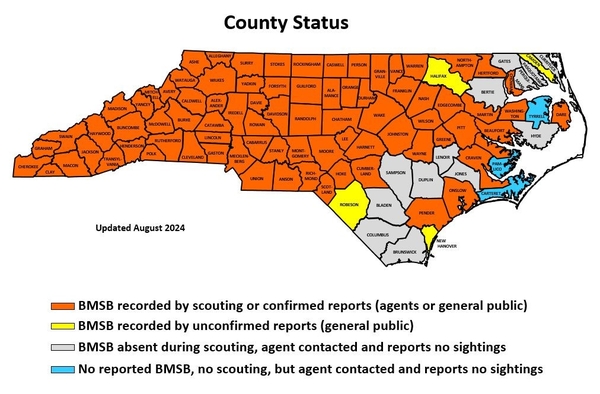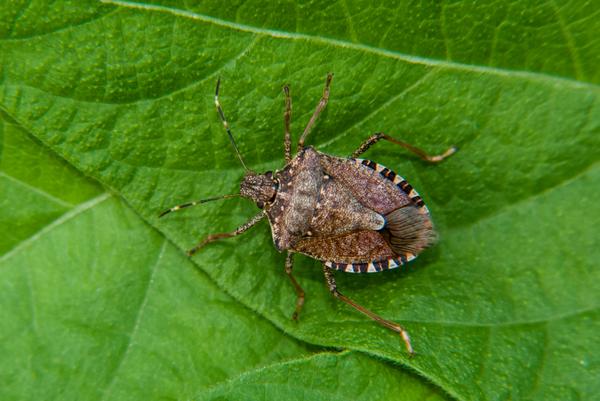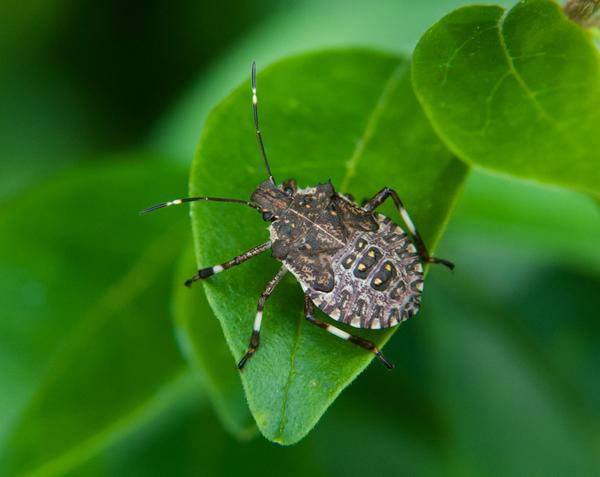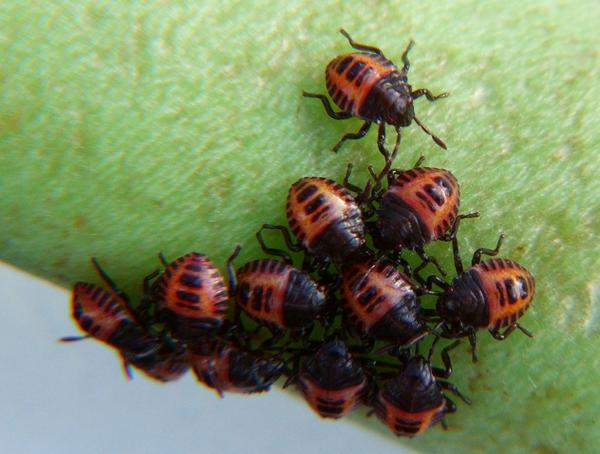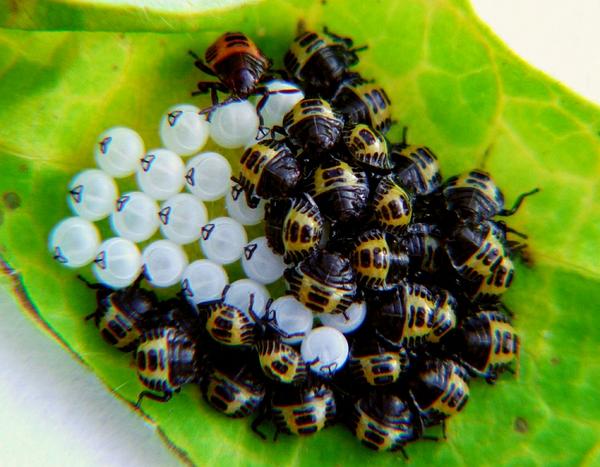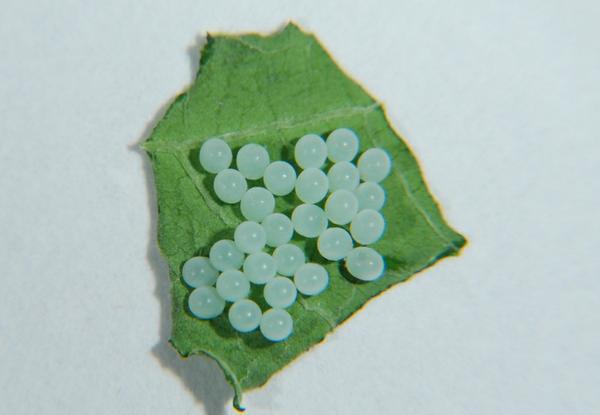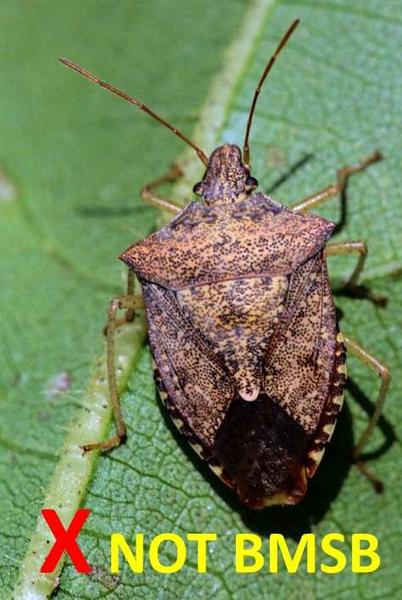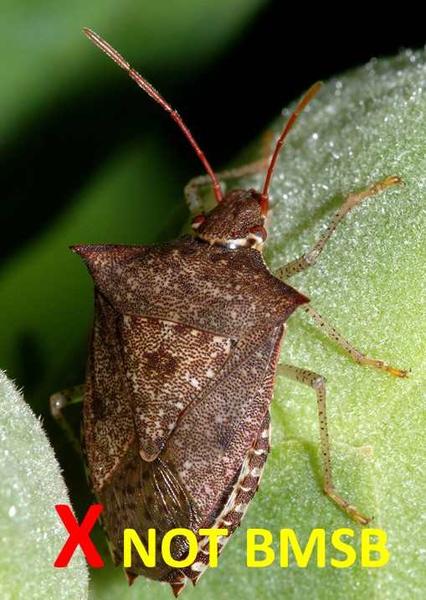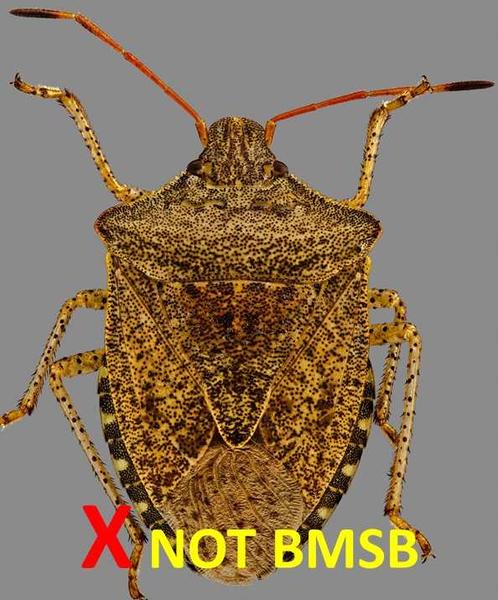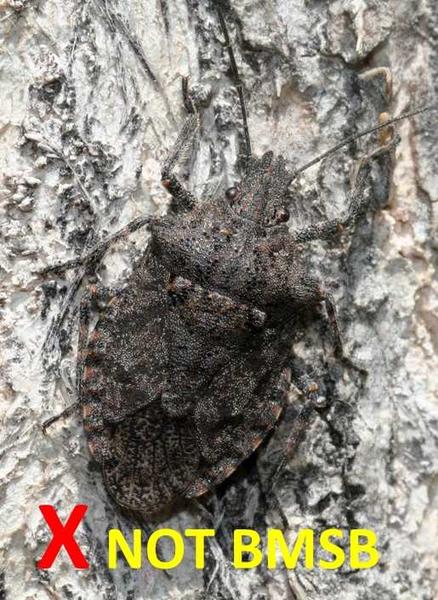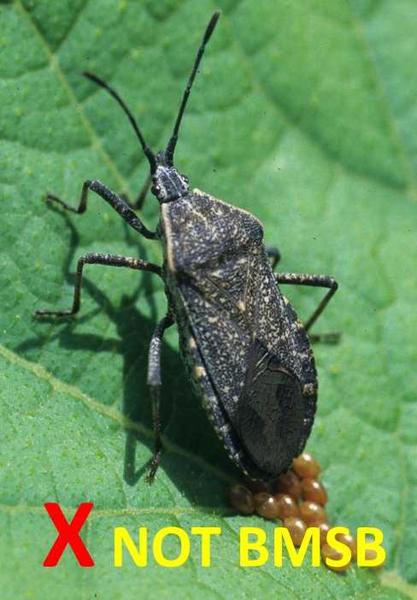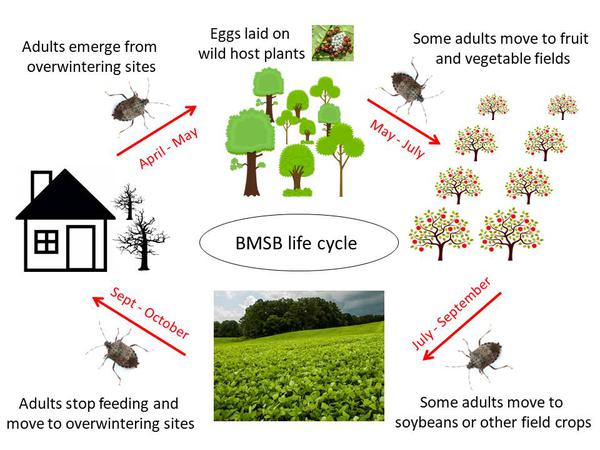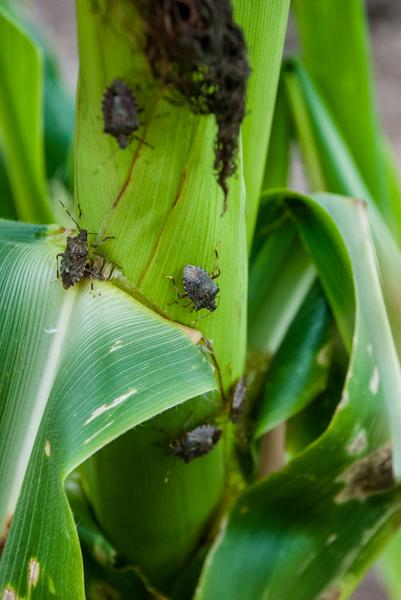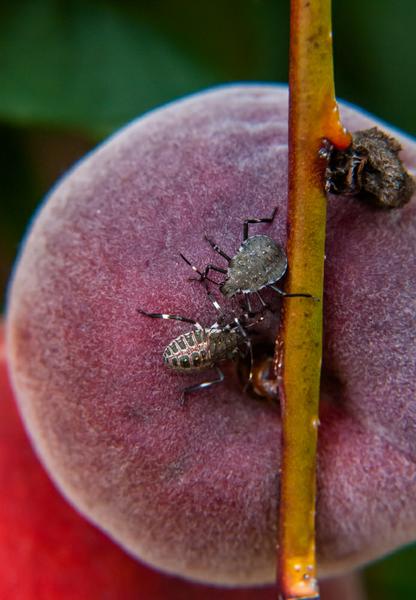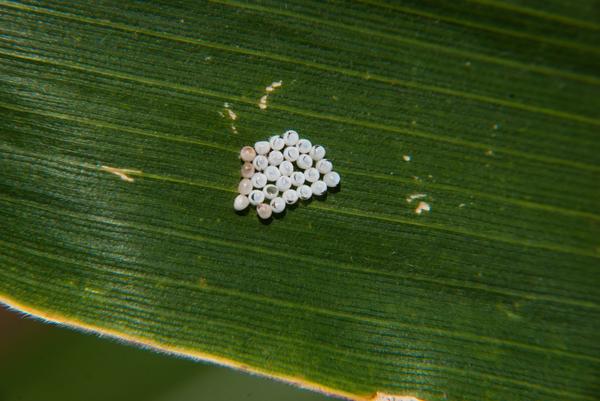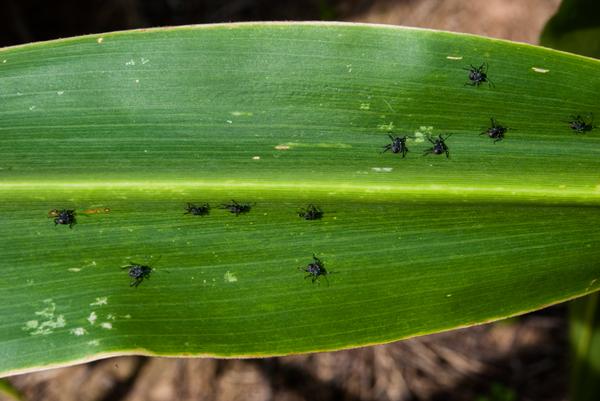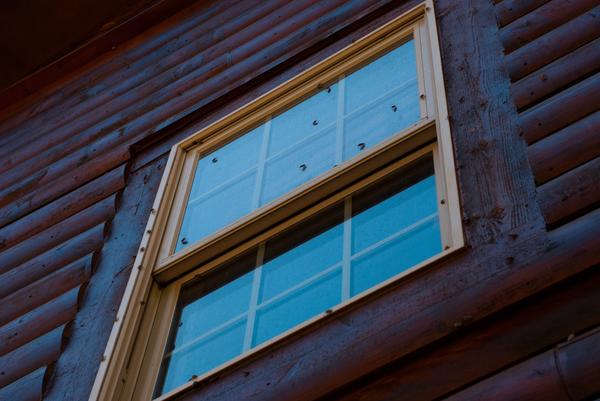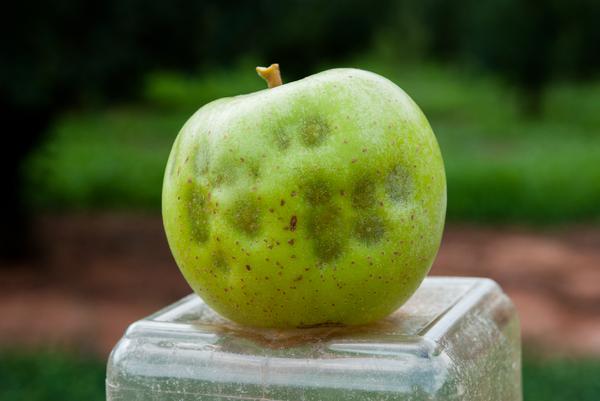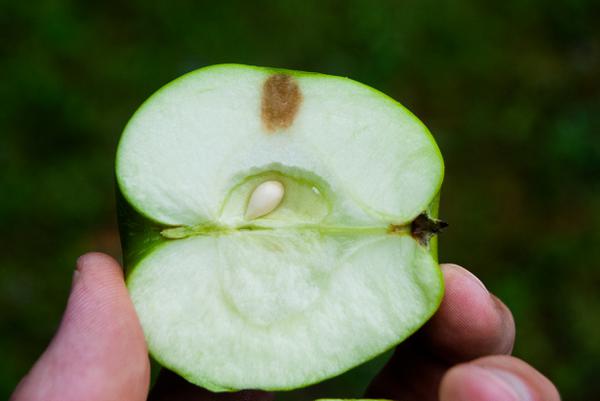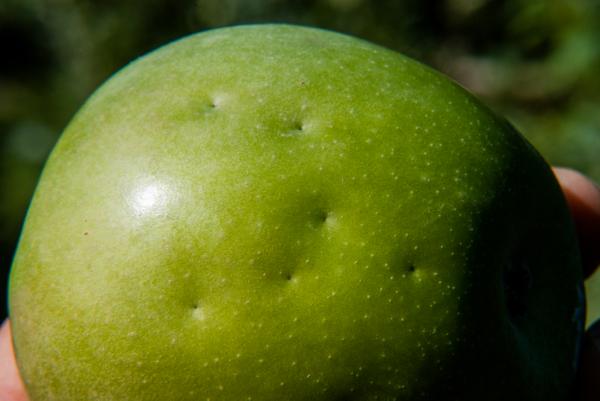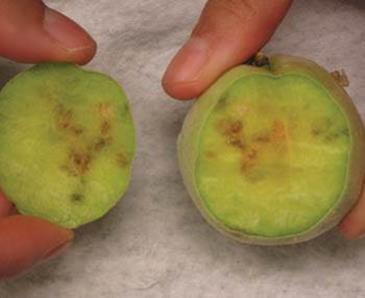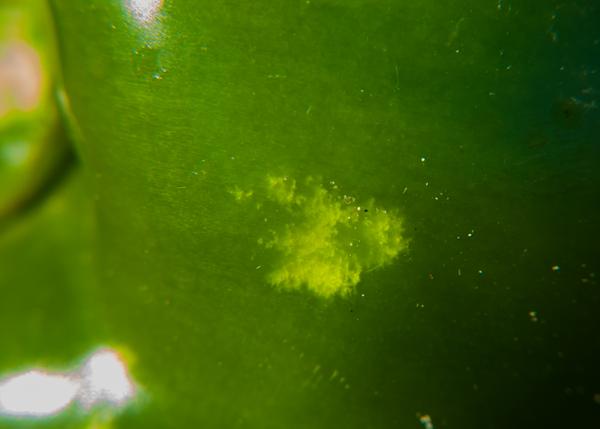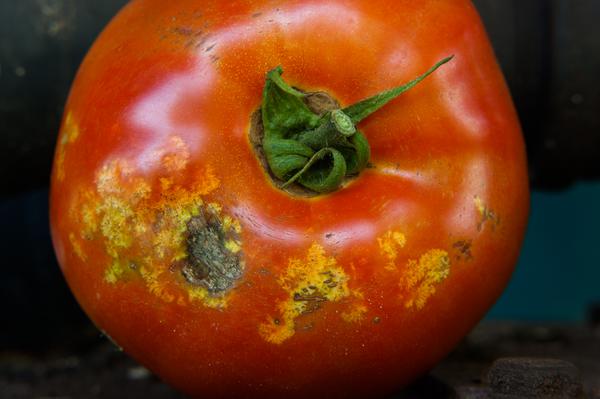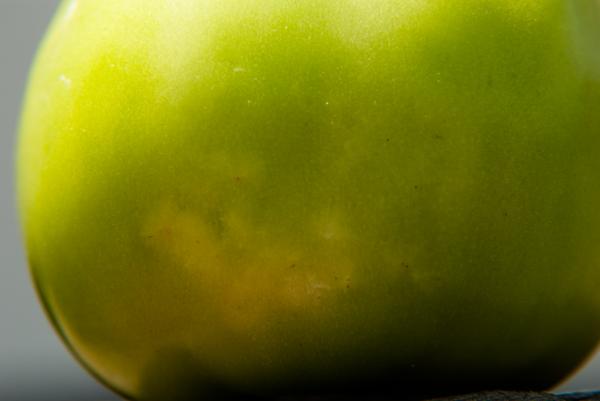Insecticides are currently the most practical option for managing BMSB in agricultural and home garden settings. Insecticides belonging to the pyrethroid and neonicotinoid classes are most effective. Home gardeners should look for products containing the active ingredient bifenthrin, cyfluthrin, or lambda-cyhalothrin. Organic gardeners have very limited options and may need to spray frequently to target BMSB in its immature stages. Organic products like Azera (a mixture of azadiractin and pyrethrins) and Entrust (spinosad) have shown activity in research trials.
Naturally occurring biological control agents can help to reduce populations, with BMSB eggs being the stage that is most vulnerable to biological control. Native species of tiny parasitic wasps such as Anastatus reduvii and Telenomus podisi have done little to control BMSB, but an Asian species, Trissolcus japonicus, has much more promise. T. japonicus has been discovered in thirteen states in the US (including North Carolina), presumably after being imported accidentally with BMSB. Scientists are studying ways to use it in biological control projects.
Research also aims to develop additional management strategies, including the use of trap crops, pheromones to attract stink bugs to insecticidal nets, and other cultural approaches.
For control in homes and other structures, insecticide sprays are not always effective due to the mobile nature of the stink bugs, the constant influx of new stink bugs from outside, and the difficulty of treating populations without contaminating living areas. In addition, leaving large numbers of dead BMSB inside attics or walls can lead to further infestations of unwanted pests, such as carpet beetles. A better method is to remove individuals with a vacuum as they appear in living spaces and discard them after placing them in a freezer or drowning them in a dish of soapy water. When all BMSB have left the structure in early summer, seal all entry points (torn screens, cracks and gaps in window frames, etc) so bugs cannot return in autumn.
See the "Pest and Orchard Management Program" section of the Integrated Orchard Management Guide for Commercial Apples in the Southeast for the most current control guidelines for BMSB in apple.
In the garden, BMSB usually attack tomatoes, peppers, okra, green beans, soybeans, corn, Swiss chard, peaches, apples, pears, plums and caneberries (i.e., most common crops). Damage consists of discoloration at the feeding site; rarely is plant vigor affected. Control is difficult due to the limited effectiveness of insecticides and a constant influx of BMSB from outside areas. Pyrethroid insecticides are most effective, so choose products that contain the active ingredient bifenthrin, cyfluthrin, or lambda-cyhalothrin. Options for organic growers are even more limited and require frequent sprays (possibly every couple of days under intense pressure) that target immature BMSB. Organic products that have shown activity include Azera (mixture of azadirachtin and pyrethrins) and Entrust (active ingredient spinosad). Some researchers and organic growers have also tried “trap-cropping,” the practice of growing BMSB-preferred host plants (such as sunflowers) around the actual crop in hopes of diverting stink bugs away from important fruits and vegetables. Results have been mixed and more work is needed to make this method effective.
Read more at: https://entomology.ces.ncsu.edu/faqs-brown-marmorated-stink-bug/
In the garden, BMSB usually attack tomatoes, peppers, okra, green beans, soybeans, corn, Swiss chard, peaches, apples, pears, plums and caneberries (i.e., most common crops). Damage consists of discoloration at the feeding site; rarely is plant vigor affected. Control is difficult due to the limited effectiveness of insecticides and a constant influx of BMSB from outside areas. Pyrethroid insecticides are most effective, so choose products that contain the active ingredient bifenthrin, cyfluthrin, or lambda-cyhalothrin. Options for organic growers are even more limited and require frequent sprays (possibly every couple of days under intense pressure) that target immature BMSB. Organic products that have shown activity include Azera (mixture of azadirachtin and pyrethrins) and Entrust (active ingredient spinosad). Some researchers and organic growers have also tried “trap-cropping,” the practice of growing BMSB-preferred host plants (such as sunflowers) around the actual crop in hopes of diverting stink bugs away from important fruits and vegetables. Results have been mixed and more work is needed to make this method effective.
Read more at: https://entomology.ces.ncsu.edu/faqs-brown-marmorated-stink-bug/
How do I kill BMSB in my house? Insecticide sprays are not always effective due to the mobile nature of the stink bugs, the constant influx of new stink bugs from outside, and the difficulty of treating populations without contaminating living areas. In addition, leaving a large number of dead BMSB inside attics, walls, or crawl spaces can attract more unwanted pests, such as carpet beetles. A better method is to drop captured individuals into a dish of soapy water to drown them, or to vacuum them and then freeze or discard the vacuum bag. Some homeowners with large infestations keep a hand-held, battery-powered vacuum just for BMSB removal. Admittedly, this can be time-consuming, but it is often the best option. Try not to squash or agitate BMSB in the house, which only worsens the smell, or to live-release them outdoors, where they will eventually come back inside. BMSB in attic insulation BMSB in attic insulation How do I keep BMSB out of my house to begin with? In summer, after overwintering stink bugs have left the house but before they return in autumn, seal all potential entry points with weatherstripping, caulk, or foam sealant. Check for gaps around windows and doors, place screening over attic ventilation louvers, and make sure there are no gaps or cracks around faucets and piping. An excellent University of Maryland video demonstrates “Exclusion and Execution” techniques for BMSB invaders.
Read more at: https://entomology.ces.ncsu.edu/faqs-brown-marmorated-stink-bug/
How do I kill BMSB in my house? Insecticide sprays are not always effective due to the mobile nature of the stink bugs, the constant influx of new stink bugs from outside, and the difficulty of treating populations without contaminating living areas. In addition, leaving a large number of dead BMSB inside attics, walls, or crawl spaces can attract more unwanted pests, such as carpet beetles. A better method is to drop captured individuals into a dish of soapy water to drown them, or to vacuum them and then freeze or discard the vacuum bag. Some homeowners with large infestations keep a hand-held, battery-powered vacuum just for BMSB removal. Admittedly, this can be time-consuming, but it is often the best option. Try not to squash or agitate BMSB in the house, which only worsens the smell, or to live-release them outdoors, where they will eventually come back inside. BMSB in attic insulation BMSB in attic insulation How do I keep BMSB out of my house to begin with? In summer, after overwintering stink bugs have left the house but before they return in autumn, seal all potential entry points with weatherstripping, caulk, or foam sealant. Check for gaps around windows and doors, place screening over attic ventilation louvers, and make sure there are no gaps or cracks around faucets and piping. An excellent University of Maryland video demonstrates “Exclusion and Execution” techniques for BMSB invaders.
Read more at: https://entomology.ces.ncsu.edu/faqs-brown-marmorated-stink-bug/
How do I kill BMSB in my house? Insecticide sprays are not always effective due to the mobile nature of the stink bugs, the constant influx of new stink bugs from outside, and the difficulty of treating populations without contaminating living areas. In addition, leaving a large number of dead BMSB inside attics, walls, or crawl spaces can attract more unwanted pests, such as carpet beetles. A better method is to drop captured individuals into a dish of soapy water to drown them, or to vacuum them and then freeze or discard the vacuum bag. Some homeowners with large infestations keep a hand-held, battery-powered vacuum just for BMSB removal. Admittedly, this can be time-consuming, but it is often the best option. Try not to squash or agitate BMSB in the house, which only worsens the smell, or to live-release them outdoors, where they will eventually come back inside. BMSB in attic insulation BMSB in attic insulation How do I keep BMSB out of my house to begin with? In summer, after overwintering stink bugs have left the house but before they return in autumn, seal all potential entry points with weatherstripping, caulk, or foam sealant. Check for gaps around windows and doors, place screening over attic ventilation louvers, and make sure there are no gaps or cracks around faucets and piping. An excellent University of Maryland video demonstrates “Exclusion and Execution” techniques for BMSB invaders.
Read more at: https://entomology.ces.ncsu.edu/faqs-brown-marmorated-stink-bug/
How do I kill BMSB in my house? Insecticide sprays are not always effective due to the mobile nature of the stink bugs, the constant influx of new stink bugs from outside, and the difficulty of treating populations without contaminating living areas. In addition, leaving a large number of dead BMSB inside attics, walls, or crawl spaces can attract more unwanted pests, such as carpet beetles. A better method is to drop captured individuals into a dish of soapy water to drown them, or to vacuum them and then freeze or discard the vacuum bag. Some homeowners with large infestations keep a hand-held, battery-powered vacuum just for BMSB removal. Admittedly, this can be time-consuming, but it is often the best option. Try not to squash or agitate BMSB in the house, which only worsens the smell, or to live-release them outdoors, where they will eventually come back inside. BMSB in attic insulation BMSB in attic insulation How do I keep BMSB out of my house to begin with? In summer, after overwintering stink bugs have left the house but before they return in autumn, seal all potential entry points with weatherstripping, caulk, or foam sealant. Check for gaps around windows and doors, place screening over attic ventilation louvers, and make sure there are no gaps or cracks around faucets and piping. An excellent University of Maryland video demonstrates “Exclusion and Execution” techniques for BMSB invaders.
Read more at: https://entomology.ces.ncsu.edu/faqs-brown-marmorated-stink-bug/
How do I kill BMSB in my house? Insecticide sprays are not always effective due to the mobile nature of the stink bugs, the constant influx of new stink bugs from outside, and the difficulty of treating populations without contaminating living areas. In addition, leaving a large number of dead BMSB inside attics, walls, or crawl spaces can attract more unwanted pests, such as carpet beetles. A better method is to drop captured individuals into a dish of soapy water to drown them, or to vacuum them and then freeze or discard the vacuum bag. Some homeowners with large infestations keep a hand-held, battery-powered vacuum just for BMSB removal. Admittedly, this can be time-consuming, but it is often the best option. Try not to squash or agitate BMSB in the house, which only worsens the smell, or to live-release them outdoors, where they will eventually come back inside. BMSB in attic insulation BMSB in attic insulation How do I keep BMSB out of my house to begin with? In summer, after overwintering stink bugs have left the house but before they return in autumn, seal all potential entry points with weatherstripping, caulk, or foam sealant. Check for gaps around windows and doors, place screening over attic ventilation louvers, and make sure there are no gaps or cracks around faucets and piping. An excellent University of Maryland video demonstrates “Exclusion and Execution” techniques for BMSB invaders.
Read more at: https://entomology.ces.ncsu.edu/faqs-brown-marmorated-stink-bug/
How do I kill BMSB in my house? Insecticide sprays are not always effective due to the mobile nature of the stink bugs, the constant influx of new stink bugs from outside, and the difficulty of treating populations without contaminating living areas. In addition, leaving a large number of dead BMSB inside attics, walls, or crawl spaces can attract more unwanted pests, such as carpet beetles. A better method is to drop captured individuals into a dish of soapy water to drown them, or to vacuum them and then freeze or discard the vacuum bag. Some homeowners with large infestations keep a hand-held, battery-powered vacuum just for BMSB removal. Admittedly, this can be time-consuming, but it is often the best option. Try not to squash or agitate BMSB in the house, which only worsens the smell, or to live-release them outdoors, where they will eventually come back inside. BMSB in attic insulation BMSB in attic insulation How do I keep BMSB out of my house to begin with? In summer, after overwintering stink bugs have left the house but before they return in autumn, seal all potential entry points with weatherstripping, caulk, or foam sealant. Check for gaps around windows and doors, place screening over attic ventilation louvers, and make sure there are no gaps or cracks around faucets and piping. An excellent University of Maryland video demonstrates “Exclusion and Execution” techniques for BMSB invaders.
Read more at: https://entomology.ces.ncsu.edu/faqs-brown-marmorated-stink-bug/
How do I kill BMSB in my house? Insecticide sprays are not always effective due to the mobile nature of the stink bugs, the constant influx of new stink bugs from outside, and the difficulty of treating populations without contaminating living areas. In addition, leaving a large number of dead BMSB inside attics, walls, or crawl spaces can attract more unwanted pests, such as carpet beetles. A better method is to drop captured individuals into a dish of soapy water to drown them, or to vacuum them and then freeze or discard the vacuum bag. Some homeowners with large infestations keep a hand-held, battery-powered vacuum just for BMSB removal. Admittedly, this can be time-consuming, but it is often the best option. Try not to squash or agitate BMSB in the house, which only worsens the smell, or to live-release them outdoors, where they will eventually come back inside. BMSB in attic insulation BMSB in attic insulation How do I keep BMSB out of my house to begin with? In summer, after overwintering stink bugs have left the house but before they return in autumn, seal all potential entry points with weatherstripping, caulk, or foam sealant. Check for gaps around windows and doors, place screening over attic ventilation louvers, and make sure there are no gaps or cracks around faucets and piping. An excellent University of Maryland video demonstrates “Exclusion and Execution” techniques for BMSB invaders.
Read more at: https://entomology.ces.ncsu.edu/faqs-brown-marmorated-stink-bug/
How do I kill BMSB in my house? Insecticide sprays are not always effective due to the mobile nature of the stink bugs, the constant influx of new stink bugs from outside, and the difficulty of treating populations without contaminating living areas. In addition, leaving a large number of dead BMSB inside attics, walls, or crawl spaces can attract more unwanted pests, such as carpet beetles. A better method is to drop captured individuals into a dish of soapy water to drown them, or to vacuum them and then freeze or discard the vacuum bag. Some homeowners with large infestations keep a hand-held, battery-powered vacuum just for BMSB removal. Admittedly, this can be time-consuming, but it is often the best option. Try not to squash or agitate BMSB in the house, which only worsens the smell, or to live-release them outdoors, where they will eventually come back inside. BMSB in attic insulation BMSB in attic insulation How do I keep BMSB out of my house to begin with? In summer, after overwintering stink bugs have left the house but before they return in autumn, seal all potential entry points with weatherstripping, caulk, or foam sealant. Check for gaps around windows and doors, place screening over attic ventilation louvers, and make sure there are no gaps or cracks around faucets and piping. An excellent University of Maryland video demonstrates “Exclusion and Execution” techniques for BMSB invaders.
Read more at: https://entomology.ces.ncsu.edu/faqs-brown-marmorated-stink-bug/
How do I kill BMSB in my house? Insecticide sprays are not always effective due to the mobile nature of the stink bugs, the constant influx of new stink bugs from outside, and the difficulty of treating populations without contaminating living areas. In addition, leaving a large number of dead BMSB inside attics, walls, or crawl spaces can attract more unwanted pests, such as carpet beetles. A better method is to drop captured individuals into a dish of soapy water to drown them, or to vacuum them and then freeze or discard the vacuum bag. Some homeowners with large infestations keep a hand-held, battery-powered vacuum just for BMSB removal. Admittedly, this can be time-consuming, but it is often the best option. Try not to squash or agitate BMSB in the house, which only worsens the smell, or to live-release them outdoors, where they will eventually come back inside. BMSB in attic insulation BMSB in attic insulation How do I keep BMSB out of my house to begin with? In summer, after overwintering stink bugs have left the house but before they return in autumn, seal all potential entry points with weatherstripping, caulk, or foam sealant. Check for gaps around windows and doors, place screening over attic ventilation louvers, and make sure there are no gaps or cracks around faucets and piping. An excellent University of Maryland video demonstrates “Exclusion and Execution” techniques for BMSB invaders.
Read more at: https://entomology.ces.ncsu.edu/faqs-brown-marmorated-stink-bug/
In the garden, BMSB usually attack tomatoes, peppers, okra, green beans, soybeans, corn, Swiss chard, peaches, apples, pears, plums and caneberries (i.e., most common crops). Damage consists of discoloration at the feeding site; rarely is plant vigor affected. Control is difficult due to the limited effectiveness of insecticides and a constant influx of BMSB from outside areas. Pyrethroid insecticides are most effective, so choose products that contain the active ingredient bifenthrin, cyfluthrin, or lambda-cyhalothrin. Options for organic growers are even more limited and require frequent sprays (possibly every couple of days under intense pressure) that target immature BMSB. Organic products that have shown activity include Azera (mixture of azadirachtin and pyrethrins) and Entrust (active ingredient spinosad). Some researchers and organic growers have also tried “trap-cropping,” the practice of growing BMSB-preferred host plants (such as sunflowers) around the actual crop in hopes of diverting stink bugs away from important fruits and vegetables. Results have been mixed and more work is needed to make this method effective.
Read more at: https://entomology.ces.ncsu.edu/faqs-brown-marmorated-stink-bug/

BMSB eggs eaten by predatory insects.
Rachel Suits, NC State University
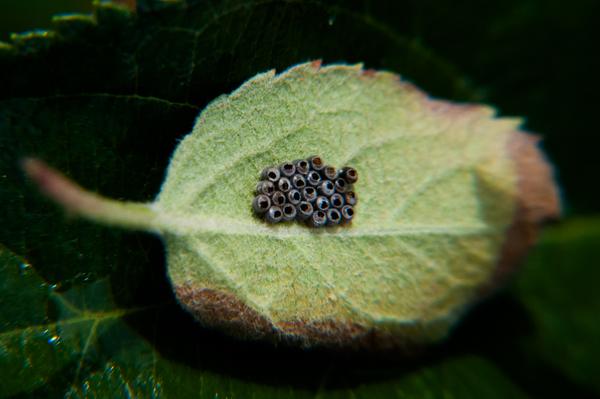
Parasitized BMSB eggs.
Steve Schoof, NC State University
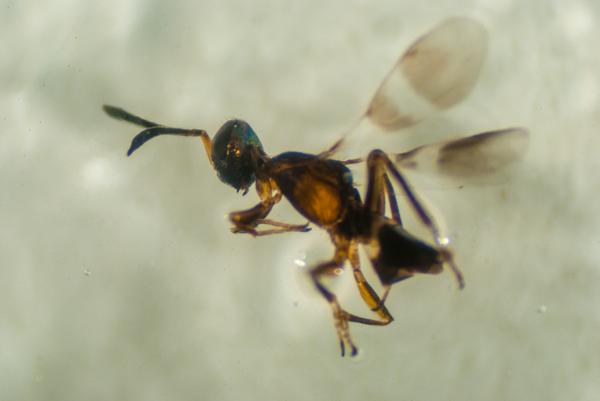
Anastatus reduvii (parasitic wasp).
Dylan Tussey, NC State University
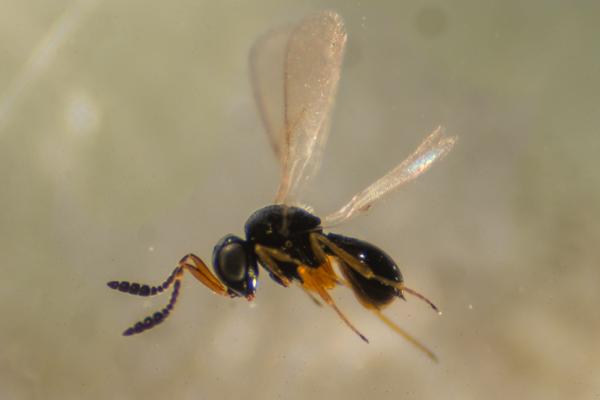
Telenomus podisi (parastic wasp).
Dylan Tussey, NC State University
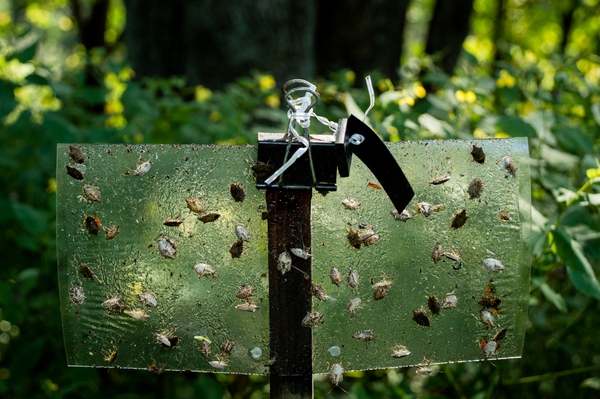
BMSB monitoring trap comprised of sticky card and attractant.
Steve Schoof, NC State University.
Publication date: Feb. 23, 2015
Reviewed/Revised: March 10, 2022

